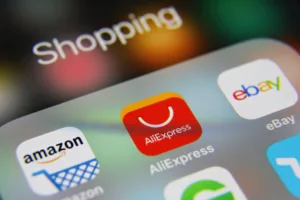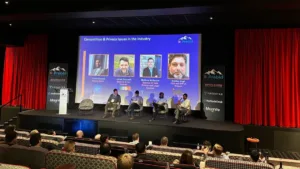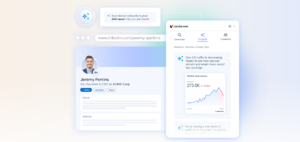By Chris Hogg, CRO of Lotame
Generative AI is sweeping through the digital publishing industry, leaving fear and excitement in its wake. Buzzfeed has been bullish on using AI to generate content, while the Financial Times and WIRED have pledged that their journalism will continue to be reported and written entirely by humans — though neither are opposed to using AI tools for data mining, research, analysis, and translation.
But one of the most significant impacts of AI is not in how content is produced, but in how it is discovered. Microsoft’s new ChatGPT-powered Bing and Google’s Bard-powered Search Generative Experience (SGE) answer search queries with AI-generated text rather than the traditional list of links — effectively turning Google and Bing into publishers themselves. This creates tension with traditional publishers whose content has fed the large language models (LLMs) that power generative AI, and whose uniquely well-defined audiences provide touchpoints for advertisers that cannot be replicated elsewhere.
Bing and Bard battle it out for search supremacy
It’s still early days for AI search. Google’s SGE is in limited beta and, like the in-preview Bing Chat, is prone to “hallucinations”, including step-by-step installation guides that would break the user’s computer and offering medical advice without credentials.
Despite current shortcomings, AI search is set to transform how people find information. Asking a question in natural language offers a more intuitive experience than translating a query into search engine prompts. Combined with the convenience of not having to leave the current window to find an answer, it’s hard not to see this becoming the new standard, particularly for younger people with fewer time-worn habits.
If search no longer includes any actual “searching”, the clicks that send a steady stream of traffic to digital publishers will reduce to a trickle. HubSpot estimates that search accounts for around a quarter of web traffic, and while the exact proportion will vary from publisher to publisher, the flat growth and declining ad revenues in the wider industry leaves little room for losses. Digital publishers are used to playing leapfrog with Google’s SEO algorithms, but now they must reckon with being excluded from the process entirely.
Google may end up sharing Bard ad revenues with publishers that contributed to its content (as it did, reluctantly, with Snippets in the EU) and Microsoft has made vague promises to do the same. Microsoft has even stated that it intends to “drive more traffic to publishers in this new world of search”, though it’s hard to imagine how this outcome can be achieved. It’s safer for publishers to assume that any lost search revenues will not return.
It’s not just publishers who would lose from this shift in how web users seek information. The black box models of walled gardens have long frustrated advertisers seeking transparent performance and audience insights. Generative AI search — which is designed to keep a user locked to a single page — threatens to create the highest walls yet. Further consolidation of audiences into the hands of two tech giants would undermine the diverse and open ecosystem and the rich variety of addressable, specialist audiences that it supports.
The best defence against AI might be…more AI
It will be some time before legal precedents and regulations can catch up with the breakneck speed that AI is progressing. Until then, publishers must find ways to increase and protect their revenues, and it’s here that AI can be a friend rather than a foe. Though many publishers are opposed to using AI to produce content, the number crunching and predictive capabilities of today’s AI can accelerate and optimise operations.
A key strategy for audience growth and diversified revenue streams is to distribute content across many platforms. Typically, this involves laborious repurposing work to optimise content for each channel, such as taking snippets from a written article for an Instagram post, or reformatting a long-form YouTube video for a short-form vertical video for TikTok and Reels. AI tools can automate this process (with human oversight to catch errors), allowing resources to be redirected towards original content.
Many publishers are also sitting on vast archives that have rich potential to be resurfaced for nostalgia-triggering posts and retrospective series, as WIRED has been doing for its 30th anniversary. But trawling through archives is time and resource intensive, and that’s assuming the content has been updated for compatibility with the publication’s current CMS. By using AI to collate, tag, and explore their archives, publishers can transform legacy content from a backend burden into a revenue-generating asset.
Then there’s audience data, the collection and activation of which has been a top priority for publishers in the post-GDPR and soon to be post-cookie internet. The predictive graphing capabilities of modern data platforms may not have the headline-grabbing, apocalyptic allure of generative AI, but they have quietly revolutionised audience intelligence. Using such tools, publishers can layer first-party data with second and third-party sources — as well as enable compatibility with ID solutions and clean rooms — to gain a more complete and off-platform view of their audiences.
It’s these audiences that are under threat if AI becomes more trusted for their expertise than the journalists backed by publishers. Any advertisers lured by the promise of these new search platforms must ask what is more valuable to them. Do they want to target audiences across two unaccountable platforms operated end-to-end by opaque algorithms? Or do they want to target audiences across an array of publishers who offer direct relationships and can verify the provenance of every data point they possess?
It’s clear that AI presents both risks and rewards for publishers and the advertisers that need their audiences, while Google and Microsoft must be careful not to undermine human content creators. Behind big tech’s biggest hype cycle yet, generative AI is most accurately described — in the term coined by linguist Emily M. Bender — as a “stochastic parrot”. In short, such models can produce convincing impressions of human creation but are incapable of originality or imagination.
If big tech’s appetite for disruption creates an ecosystem where publishers cannot fund original content, frontline reporting, and investigative journalism, then what content will be left to inform algorithms? Publishers are the geese that lay the golden eggs for the open internet, and the wider digital industry must come together to protect them from the crossfire of Google and Microsoft’s battle for search supremacy.









